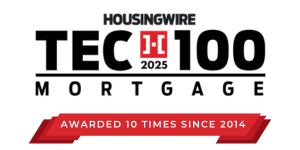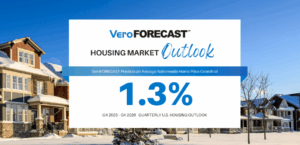The COVID-19 pandemic revealed new migration trends that show a shift toward the inner United States, thereby boosting home prices, especially in markets such as Boise City, Idaho.
The bigger question remains: is this growth likely to continue into 2021? Or is this just a hot trend that will fizzle out sooner than later.
Digging deeper into our forecast, the overall average forecast is 5.9% by Q4 2021, an additional increase of 0.9 percentage points compared to 5% just a quarter ago. This level of change from one quarter to the next is heavily driven by the ultra-low interest rates and population migration trends.
Veros data shows that several states in the western portion of the country are leading the national price increases. Cities in Idaho, Washington, Arizona, Utah, and Colorado comprise the entirety of the Top 10 metro areas.
Freddie Mac® reports that over the past few years, the nationwide trend has been to move toward the suburbs and away from the urban city centers. The fastest-growing U.S. cities have been in the southern and western states. Downtown Phoenix (AZ), Houston (TX), San Antonio (TX), Los Angeles (CA), and Austin (TX) are among the top ten urban areas that have experienced the most population increases.
Within the South, Texas and Florida witnessed the greatest increases in population, and most of the growth in metro areas in these states has been taking place in the suburbs as compared to the cities. In fact, 60 percent of all metro areas are experiencing more growth in the suburbs than in cities. That is mainly driven by millennials reaching major life events such as marrying and having children and thus are seeking larger homes and amenities such as good schools.
However, the COVID-19 pandemic has shifted this migration trend towards the interior of the country rather than the coastal metropolitan areas that have been so popular the past few decades.
Why is that happening? Many of these cities are benefiting from new household formation from parts of the country such as California that is experiencing population exodus.
Also driving that trend is global warming and concerns over rising seas have put coastal cities in threat for decades. The sea surrounding Florida is expected to increase six inches in the next 15 years, which would be devastating to certain real estate markets. Meanwhile Boise is not a coastal city, so that’s not a concern for the midsized, Western city, and that doesn’t take into account the additional accolades it received in recent years.
In 2019, Boise was named the best place for millennials to live in the US by Livability and the best place in the country to buy a home by WalletHub. Boise saw an 18.2% population jump from 2010 to 2018 — and it was the fastest-growing city in the country between 2017 and 2018, according to Forbes.
The one downside to living in Boise? According to Business Insider, it’s the lack of public transportation that is the missing gem in this crown jewel. For many potential homeowners who already travelled to the city in their own cars, it’s easy to see why that one sticky point is not a dealbreaker. Taken with other factors, it’s easy to see why the VeroFORECAST shows that the home price appreciation in the above cities will continue strengthening with Boise City leading the way by an astonishing 14.1% by Q4 2021.







